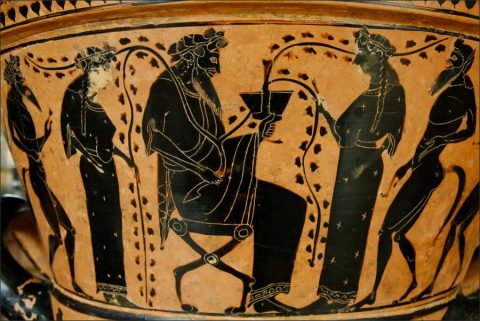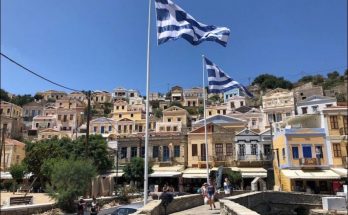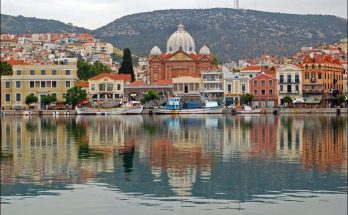The Greeks possessed, as we have seen, to an exceptionally high degree the vivid anthropomorphic imagination necessary for the expression of their conception of the gods in their art; we have also noticed the conditions which encouraged or restricted such representation, and the influences that affected its nature. Given the desire to represent the character and individuality of the gods in human form, the next question we have to consider is how far their art, and especially the art of sculpture, was capable of giving effect to this desire.
The answer lies mainly in the history of Greek sculpture, which can only be touched on here in the barest outline. But, at the outset, it is necessary to remove a misconception which is prevalent at the present day, and more especially in England, owing partly to the dominating influence of a great critic. Mr. Ruskin Aratra Pentelici is full of the most admirable and suggestive appreciations of Greek sculpture in its more technical aspects; but side by side with them are found passages such as the following: “There is no personal character in true Greek art; abstract ideas of youth and age, strength and swiftness, virtue and vice — yes; but there is no individuality.” Or again: “The Greek, as such, never expresses personal character, while a Florentine holds it to be the ultimate condition of beauty.”
If this criticism were just, it would follow that any study of the relation of religion to art in Greece would lose most if not all of its interest. But anyone who is acquainted with the present state of our knowledge of Greek sculpture will not so much feel called upon to refute such statements as to explain how so strange a misconception could have arisen. Nor is the explanation very far to seek. Mr. Ruskin was writing for a generation not yet penetrated by the constructive criticism of recent investigation. Its conception of “the antique” in art was based mainly on the mass of mechanical and academic copies or imitations, of GræcoRoman date, with which our museums are filled, and on the influence of such sculpture to be seen in the work of Flaxman or Thorwaldsen.
It had, indeed, learnt from the Elgin marbles that the Greek sculptors in the fifth century possessed a nobility in their conception of the human form, a mastery in the treatment of the nude and of drapery, and a skill in marble technique of which only a faint reflection can be traced in the later Græco-Roman tradition; but the great statues in which the sculptors of the fifth century embodied their ideals of the gods were either entirely lost or preserved only in inadequate copies; and it is only in recent years that the discovery of originals or the identification of trustworthy copies has enabled us to appreciate the intensity of expression and of inner life which distinguished the work of the great sculptors of the fourth century, such as Scopas, Praxiteles, and Lysippus.
Still, if Mr. Ruskin had, like Brunn in his Götteridealen, selected heads like those of the Demeter of Cnidus or the Hera Farnese to illustrate his theme, instead of a series of heads on coins magnified to many times the size for which they were designed, he could hardly have written the passages just quoted. But the second of those passages itself supplies us with another clue. In this estimate of Greek sculpture there is throughout implied a comparison with Christian, and above all with Florentine art, and its desire to “…bring the invisible full into play; Let the visible go to the dogs; what matters?”
It is evident that the expression of the invisible, of character and individuality, will be more striking and obvious in an art which lets them “shine through the flesh they fray” than in the case of the Greek sculptors whose respect and even passionate admiration for the human body would not allow them thus to transfigure it, at least in their statues of the gods, and led them to seek for subtler methods of expression by means of the flesh and in harmony with its nature. Their expression of character and emotion is rendered in terms of a beautiful and healthy body.
How this end was attained we must consider later on; but there is yet another current prejudice in favour of this exaggeration of individuality which has its influence especially upon modern artists. It is sometimes said nowadays that a departure from the individual model is an attempt to “improve upon nature,” and is therefore an artistic mistake.
Now the Greek sculptor, as a rule, did not work from an individual model at all. He trusted partly, especially in earlier times, to the tradition which familiarised him with a few fixed types, on which he made variations, partly to his observation and memory trained for generations, and daily supplied with new material in the gymnasium where nude youths and men were constantly exercising, or in the marketplace where he met his fellow-citizens. To see before him, whether draped or nude, the figures he wanted for his art, he had no need to pose a model in a studio; his models were at all times around him in his daily life.
The result was that when he wished to represent a youth or a maiden, or even to make a portrait of a statesman, he tended to reproduce the type with certain personal modifications rather than to produce a portrait in the modern sense. But when he came to making statues of the gods, his freedom of hand was of incalculable service to him in giving a bodily form to his imagination; it enabled him to create after nature, without being dependent on an individual model or having to fall back upon such vague and generalised forms as are sometimes associated with an academic or classical art; for it was his own trained observation and memory that he called into play, not a mere mechanical system he had learnt from his predecessors.
In the more individualistic art of the fourth century, as we shall see, it is probable that the personal model was of more importance, especially in female statues; but even then it was still modified by the tradition and style which makes a harmonious whole, not only of each Greek statue, but of the development of Hellenic sculpture generally. In typical examples of the sculpture of the fourth century we find not only this harmony and restraint, and the beauty of bodily form in figure as well as in features which is generally recognised as characteristic of Greek art, but also an expression of character and individuality, of mood and temperament, of pathos and passion, which is none the less intense and real because it is expressed by means of the perfection of physical form, not as wasting or deforming it.
It may be asked how the invisible, mental, or spiritual qualities can be portrayed in visible form, especially if that visible form be not overmuch distorted or modified, and in a more general way, how the expression of a statue, and the impression it produces, can be analysed or discussed. For examples of the way this can be done, the reader may be referred once more to Brunn Götteridealen, a study of a few selected representations of Greek gods in which the character of each is brought out by a subtle and discriminating analysis of the visible forms.
Here it may suffice to quote Brunn’s own words from the Introduction to that work: “The spiritual effect produced on us by a work of sculpture cannot be comprehended as a moral or a metaphysical peculiarity, completely independent of corporeal phenomena; it can become intelligible to us only by means of tangible sculptural forms, as the exponents of spiritual expression.” And again: “The spiritual understanding of ideal artistic creations can only be attained on the basis of a thorough analysis of their forms”; hence in such a study we have to do with “no subjective fancies, but an investigation of objective artistic principles, according to the method of scientific work.”
There are various ways in which spiritual qualities, mood, and character may be given material expression in harmony with the bodily forms, not in combat with the flesh. There are, for instance, certain bodily peculiarities that usually accompany, and therefore suggest by association, various temperaments or mental qualities; and, moreover, the actual effect upon the features and bearing of certain emotions or moods often leaves permanent traces, from which a habitual or repeated tendency to such emotions or moods can be inferred.
That certain types of face and certain expressions are usually associated with certain spiritual or mental qualities will hardly be denied; and here the method of the Greek artist, in observing and working from memory rather than from a posed model, gave him a great advantage in variety and freedom in the expression of character no less than in the rendering of bodily form.
If he realised clearly the individuality of his gods, his skill and mastery over his material and his store of observation gave him a facility in giving this individuality a visible form which may not be so obvious at first sight as the individuality of a Florentine or of a modern head, but which is none the less there for those who have eyes to see it, and who can accustom themselves to the subtle atmosphere of ancient art, and to the moderation and restraint which are seldom, if ever, violated in its most characteristic productions.
Visits: 127



